WEB EXHIBITIONS AND OTHER CONTENT
JACAR offers special web exhibitions and other thematic explorations that focus on the documents and records relating to the important historical events and persons.
“Topics” from JACAR (Japanese Only)
“Topics” offer the documents concerning to the important historical events and persons, especially for the beginners of JACAR website and for the nonspecialist readers.
Japan Center for Asian Historical Records | Japanese-English Bilingual Translations Collection
You can find historical terminology by "Category" or "Alphabetical Index", as well as corresponding Japanese translations of the terminology.
Teaching Materials for Social Studies Education (Japanese Only)
A list of historical documents useful for the social studies education especially for teachers of junior and senior high schools.
Web exhibitions and special features
Exhibitions explore important historical events through official documents. Some of the Japanese version exhibitions are not available in English translation.
-
Japan's Army during the Meiji and Taisho Eras ―1868~1926―
 (Released in June 2021)
(Released in June 2021)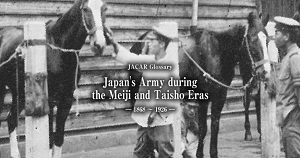
The year 2021 marks the 150th anniversary of the establishment of national armed forces by the Meiji Government. In 1871, the Meiji Government first created armed forces under the government control by unifying armed groups which had previously been organized by feudal domains. The Meiji Government also divided the country into several regions and established army garrisons for each region. In 1871, the Meiji Government also created the departments of Army and Navy within the Ministry of War.
On this occasion, we compiled a collection of terms related to the Imperial Army of Japan by focusing on the Meiji and Taisho periods. It covers the formation of Japan’s modern military, the First Sino-Japanese War, the Russo-Japanese War, and the Siberian Intervention. It is our hope that this new collection of JACAR Glossary will help you better understand the history of the Japanese army. Please note that this new collection does not cover the Showa era. -
Viewing Meiji Japan's Engagement with Asia through the Archives: The External Infrastructure and Network
(Released in June 2019)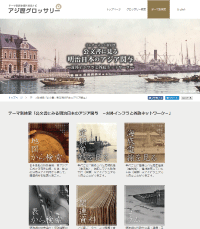
This special exhibition focuses on the relationship between Japan and East Asia during the Meiji period. It spotlights the changes that occurred during those years at central and local government institutions—particularly those involved with diplomatic affairs—and at specialized educational institutions of all types, and also the work done to create and maintain the transportation, telecommunication, and manufacturing infrastructure at the time. The exhibition does this in order to explore the question of what kind of relations Japan built with the Western powers and its closest neighbors in Asia. Three of the thematic sections—"Map-Based Search," "Look at Regular Sea Routes," and "Look at Undersea Cables"—allow you to use a map to explore such matters as the distributions of diplomatic establishments abroad, lighthouses, and mines, and the state of work that was being done to establish regular sea routes and lay undersea communication cables. Through this map, you can search for materials related to the map listings at hand.
-
The Iwakura Mission: Tracking 150 People Who Crossed the Oceans
(Released in May 2019)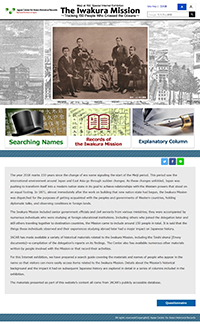
In 1871, the Japanese government dispatched the so-called Iwakura Mission for the purposes of getting acquainted with the peoples and governments of Western countries, holding diplomatic talks, and observing conditions in foreign lands. This web exhibition focuses on the people who participated in the Mission, the official records of their travel that are provided in our database, and the historical background of the Mission.
-
Homeland and Overseas, as Seen in Archival Records: Personnel Changes around Former Colonies and Occupied Territories
(Released in January 2018)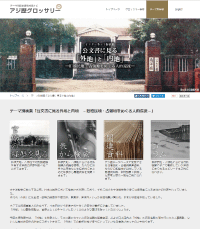
This web exhibition looks at Japan's former colonies and occupied territories from the perspective of organizational changes in the governing institutions Japan established there, personnel movements among such institutions in the Japanese homeland and the former colonies and occupied territories, and the careers of bureaucrats who worked in the former colonies. Its specific goal is to shed light on what impact the existence of these former colonies and occupied territories had on Japan's government institutions and bureaucracy.
-
Japan's Wartime and Postwar Periods Recorded:
Transformation of Japan's Governance Structure
(Released in December 2016)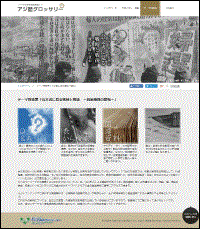
How has Japanese culture today continued to be shaped by the Second World War? In what ways have Japanese stayed rooted in a prewar social structure while absorbing policies of the Allied Occupation? This web exhibition uses public records to explore how, in the pre- and postwar periods, Japan was politically transformed in areas of economics, society and culture.
-
Post-World War Two:
Demobilization and Repatriation
(Released in February 2016)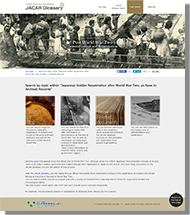
With this web exhibition, you can easily browse official documents from institutions involved in the repatriation of civilians and troops abroad at the time of the end of World War Two. You can search within records by brigade and with a variety of methods from map searches to those for organizational data and chronological tables.
-
A Window into the Early Showa Period
-Shashin Shuho: Weekly Photographical Journal, 1938-1945
(Released in March 2015)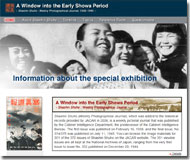
Shashin Shuho (Weekly Photographical Journal) was founded by the Cabinet Intelligence Department of Japan in February 1938. This pictorial magazine was published almost weekly for more than seven years until the 375th volume in July 1945. This exhibition traces a society, people's life and transition of the wars in the early Showa period Japan by numerous photographic articles on this journal, along with various related documents.
-
The Sino-Japanese War of 1894-1895,
as seen in prints and archives
(Released in May 2014)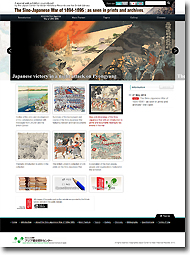
This web exhibition has been produced as a collaboration between JACAR and the British Library. Its aim is to bring together the collection of prints of the Sino-Japanese War held by the British Library and documents made public by JACAR to show how the events of the Sino-Japanese War were depicted and recorded by the people of the time.
-
The US-Japan War Talks,
as seen in official documents
(Released in May 2007)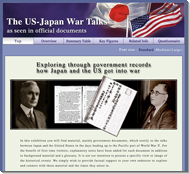
In an effort to break the deadlock between the US and Japan following the signing of the Tripartite Pact, Bishop James Walsh and Father James Drought visited Japan to make an appeal for peace to Foreign Minister Matsuoka and other Government / Army leaders. This resulted in the "Draft Understanding" which was to be presented by Ambassador Kichisaburo Nomura to Secretary of State Cordell Hull on 16 April 1941. Nomura's appointment early that year as Ambassador to the US marked a new phase in US-Japan relations.
-
The Russo-Japanese War,
as seen in official documents
(Released in May 2007)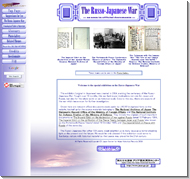
This exhibition was created in 2004, marking the centenary of the Russo-Japanese War. Fought over 18 months, this war held major implications not only for Japan and Russia, but for the whole world on an historical scale. Even to this day, there are aspects of the war which leave room for further investigation. The Russo-Japanese War, after 100 years, could enlighten us in many ways as a mirror shedding light on the present and the future.
-
Japan Center for Asian Historical Records Introduction of Released Documents on the End of the Pacific War
(Released in July 2010)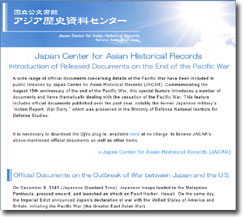
The anniversaries of the end of the World War II differ by country. It is August 15th 1945 for Japan. On that day, the Emperor himself directly announced through radio broadcast Japan's acceptance of Potsdam Declaration, which means the end of the war. This online exhibit features the documents concerning the end of the Pacific War, such as the Potsdam Declaration, Imperial Edict of the War Termination, Imperial Edict on the Declaration of War, records about Kamikaze and the battleship Yamato, as well as the Hull Note (officially named: The Outline of Proposed Basis for Agreement Between the United States and Japan).
